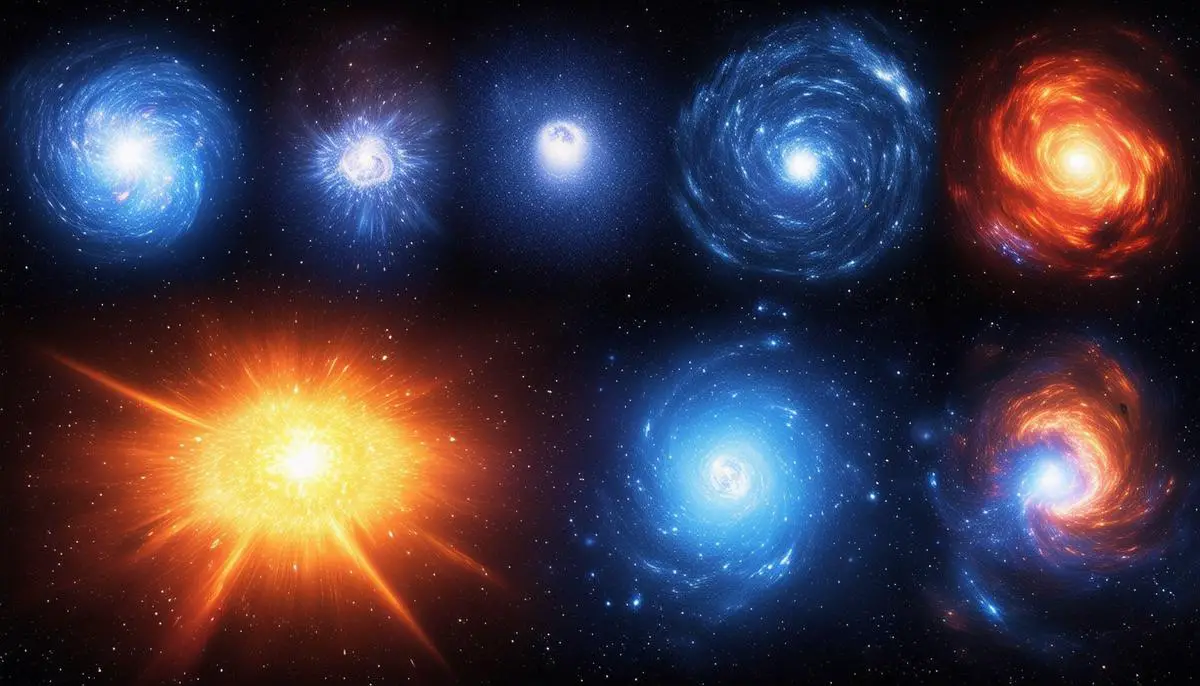Stellar Winds: Definition and Mechanisms
Stellar winds consist of charged particles, mainly high-energy protons and electrons, emanating from the surface of stars. These cosmic gusts originate from the extremely hot corona and travel through space at high speeds. The composition and velocity of stellar winds vary depending on the type of star.
For the Sun, the solar wind originates from its corona, where temperatures reach millions of degrees Kelvin. This causes particles to move faster than the Sun's escape velocity, forming the solar wind. Solar wind particles typically move at about 250 to 500 km per second.
Stellar winds from massive stars, particularly O or Wolf-Rayet stars, can carry away immense amounts of mass from the star's surface. These winds are much faster, reaching speeds around 3,500 km per second, significantly surpassing the speed of the solar wind.
Solar vs Stellar Winds
- Solar wind: Predominantly protons and electrons
- Stellar winds: Composition varies vastly
- Massive stars: Intense radiation pressure and potent magnetic fields kickstart stronger, faster winds
Stellar winds also play a role in different stages of a star's lifecycle:
- Baby stars (T Tauri stars): Strong winds help shed initial cocoons of gas and dust
- Dying stars (Red giants): Significant mass loss through stellar winds
- End stages: Formation of planetary nebulae and evolution into white dwarfs, neutron stars, or black holes
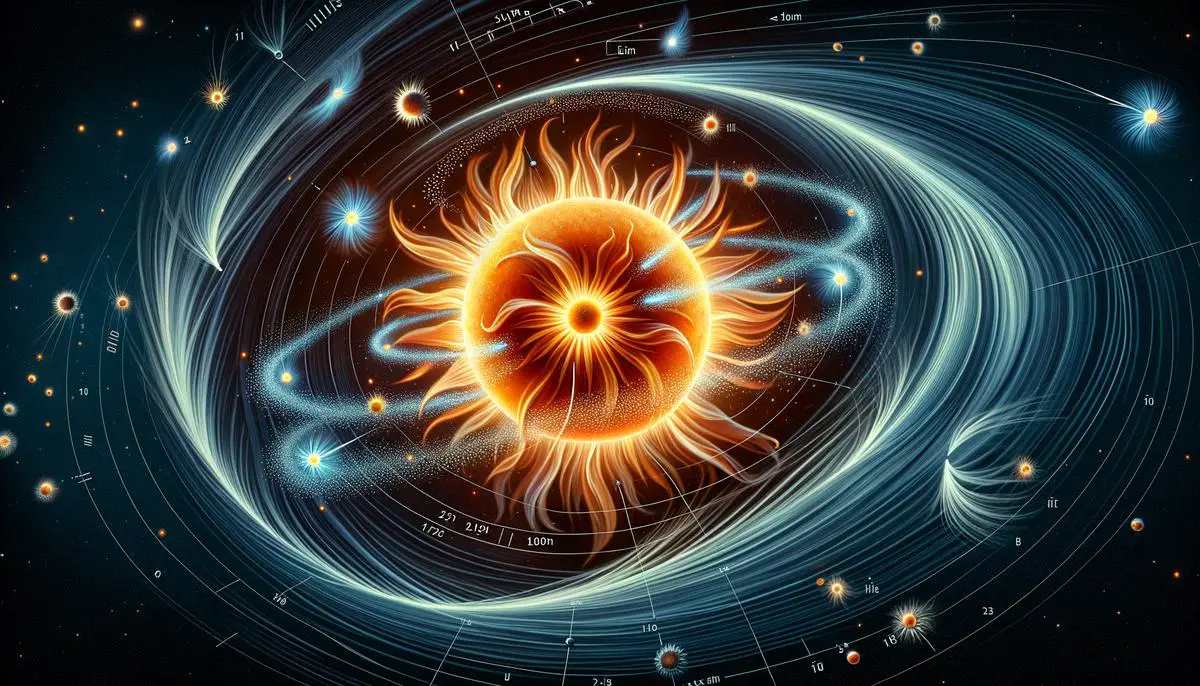
Historical Discoveries and Observations
Our understanding of stellar winds has evolved significantly over the decades. In the early 20th century, Norwegian scientist Kristian Birkeland proposed the existence of solar wind in 1916. English physicist Frederick Alexander Lindemann expanded on this idea in 1919, suggesting that the solar wind consisted of both protons and electrons.
By the 1950s, German astronomer Ludwig Biermann attributed the behavior of comet tails to their interaction with the solar wind, linking observable phenomena to the concept. The advent of space exploration allowed for direct observations:
- 1959: Soviet satellite Luna 1 made the first direct measurements of the solar wind
- 1962: NASA's Mariner 2 spacecraft identified two distinct streams of solar wind during its mission to Venus
"The Sun's superheated corona should emit charged particles at high speeds."
– Eugene Parker, 1957
Eugene Parker's mathematical framework was initially met with skepticism but was later validated by Mariner 2's detection of the solar wind in the 1960s.
The study of stellar winds extends beyond our solar system. Powerful winds from massive O-type and Wolf-Rayet stars can strip away significant amounts of matter, influencing their evolution and shaping the interstellar medium.
Modern missions continue to refine our understanding:
- NASA's Parker Solar Probe: Exploring the mysteries of solar wind origins and behavior
- ESA's Solar Orbiter: Examining the Sun's uncharted polar regions
These missions promise new insights into the mechanisms driving solar and stellar winds.
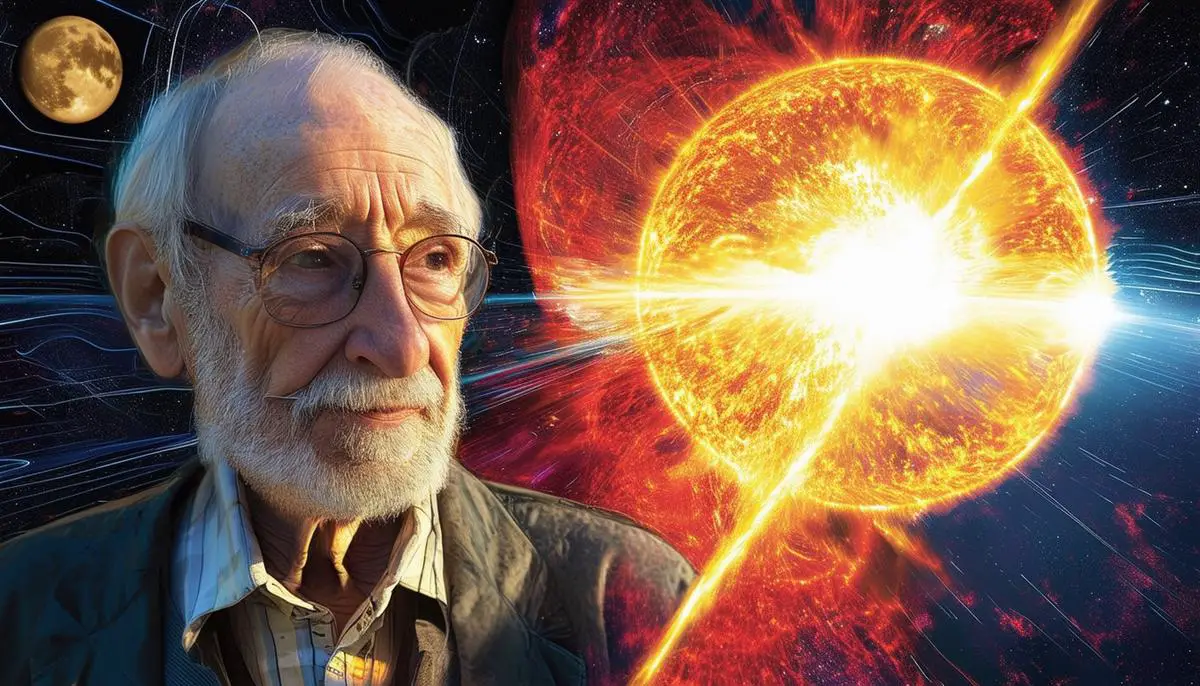
Stellar Winds and Planetary Atmospheres
Stellar winds significantly influence planetary atmospheres, both within and outside our solar system. These charged particle streams can sculpt nascent atmospheres under certain conditions but also have the potential to erode them over time, altering their habitability.
Atmospheric mass loss occurs when charged particles collide with a planet's atmosphere, imparting enough energy to knock atmospheric particles into space. This process can be severe for planets lacking a strong magnetic field. Mars, for example, is believed to have lost much of its atmosphere due to its weak magnetic field, leading to the cold, arid conditions observed today.
Earth's Protective Shield: Our planet's strong magnetic field, known as the magnetosphere, offers substantial protection against atmospheric erosion by deflecting solar wind particles. This protective bubble ensures that only a fraction of the solar wind particles interact with the atmosphere, preserving conditions conducive to life.
Exoplanets and Habitability
For exoplanets, the implications for habitability are significant. Depending on the type of star and its magnetic activity, exoplanets can face extreme stellar wind conditions:
- M-dwarf stars: Known for intense magnetic activity and frequent flares
- Powerful magnetic fields around cool stars: Can erode planetary atmospheres at high rates
- Wind speeds: Up to five times those of our solar wind
Recent simulations show that even thick atmospheres can potentially be stripped away under these conditions. The presence of a magnetosphere significantly improves the odds of habitability for a planet. However, even with a magnetic field, planets must contend with variations in their parent star's activity, particularly if they orbit closer than Earth does to the Sun.
Observational techniques, such as detecting X-ray emissions from stellar wind interactions with the interstellar medium, are providing new insights into these dynamics. Scientists have used this data to measure mass loss rates for stars like 70 Ophiuchi, Epsilon Eridani, and 61 Cygni, finding their stellar winds to be much more powerful than those of the Sun1.
Future missions like the European Space Agency's Athena are poised to further elucidate the impact of stellar winds on planetary atmospheres, deepening our understanding of habitability criteria across the cosmos.
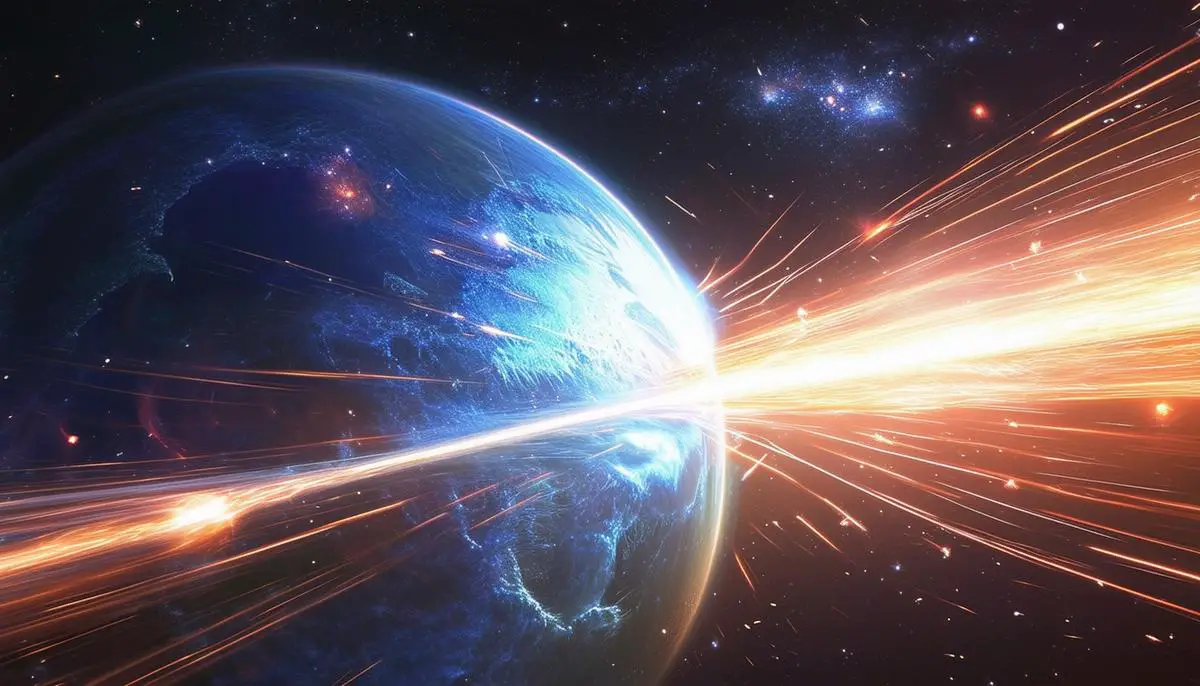
Stellar Winds in Different Types of Stars
Stellar winds exhibit remarkable diversity depending on the type of star from which they originate. This section examines the contrasting characteristics of stellar winds emanating from O-type, K-type, and M-type stars.
O-type Stars
- Among the hottest and most massive stars
- Surface temperatures: Above 30,000 Kelvin
- Wind speeds: Approximately 3,500 kilometers per second
- Driven by intense radiation pressure
- Can strip away significant portions of the star's mass
K-type Stars (Orange Dwarfs)
- Cooler and smaller than O-type giants
- Surface temperatures: 3,500 to 5,000 Kelvin
- Moderate wind speeds
- Contribute to mass loss over the star's lifetime
- Influence evolutionary trajectory, especially in red giant phase
M-type Stars (Red Dwarfs)
- Smallest and coolest of the main-sequence stars
- Surface temperatures: Typically below 3,500 Kelvin
- Strong magnetic fields trigger potent stellar winds and frequent flares
- Wind speeds: Up to five million miles per hour
- Significantly impact habitability of nearby planets
While each type of star exhibits unique wind characteristics, there are common themes in how these winds interact with their environments. All stellar winds contribute to the ongoing process of mass loss, which plays a pivotal role in stellar evolution. Additionally, the impact of these winds extends to the interstellar medium, influencing the formation and distribution of new stars and planetary systems.
As observational techniques advance, missions such as the European Space Agency's Athena and NASA's Parker Solar Probe will provide deeper insights into the nature of stellar winds from different types of stars. These endeavors will enhance our understanding of the intricate relationship between stars and their winds, ultimately enriching our broader comprehension of the cosmos2.
Stellar Winds and Solar System Formation
Stellar winds play a crucial role in shaping solar systems from their earliest stages. These cosmic breezes influence the environments where stars and planets form, affecting the processes that give rise to complex planetary systems like our own. The interaction of stellar winds with protoplanetary disks—dense, rotating disks of gas and dust surrounding young stars—is particularly significant.
Young stars like T Tauri stars exhibit strong stellar winds that disperse surrounding gas and dust, establishing initial conditions for planet formation. These winds control the amount and distribution of material available for building planets, removing excess material to allow for more stable and orderly formation within the disk.
As the young star ignites, its stellar wind begins to blow away the remaining gas, potentially halting the growth of gas giants after a certain period. The timing and intensity of this wind-clearing process determine the final structure of the planetary system:
- Faster clearing: Results in systems with more terrestrial planets
- Slower clearing: Allows for the formation of several gas giants
Stellar winds also exert pressure on dust particles within the protoplanetary disk, affecting their dynamics and helping to coalesce these particles into planetesimals—the building blocks of planets. This dust clumping is crucial for the emergence of rocky planets.
Beyond the initial stages, the long-term effects of stellar winds continue to shape solar systems. As stars mature, their winds can either strengthen or diminish, affecting the stability and orbital dynamics of surrounding planets. Changes in stellar wind characteristics can lead to increased radiation and wind pressure, potentially stripping atmospheres from nearby planets and altering the orbits of smaller bodies.
In our solar system, the Sun's solar wind has contributed to the erosion of planetary atmospheres, particularly on Mars1. The solar wind also carries the Sun's magnetic field, creating the heliosphere—a protective bubble shielding the solar system from interstellar radiation.
Long-term observational data from missions like NASA's Voyager and the Parker Solar Probe provide valuable insights into the evolving nature of our Sun's solar wind and its impact on the solar system. This information helps scientists model how young solar systems might evolve under the influence of their star's winds and predict changes in space weather, which can have implications for planetary climates and conditions conducive to life.
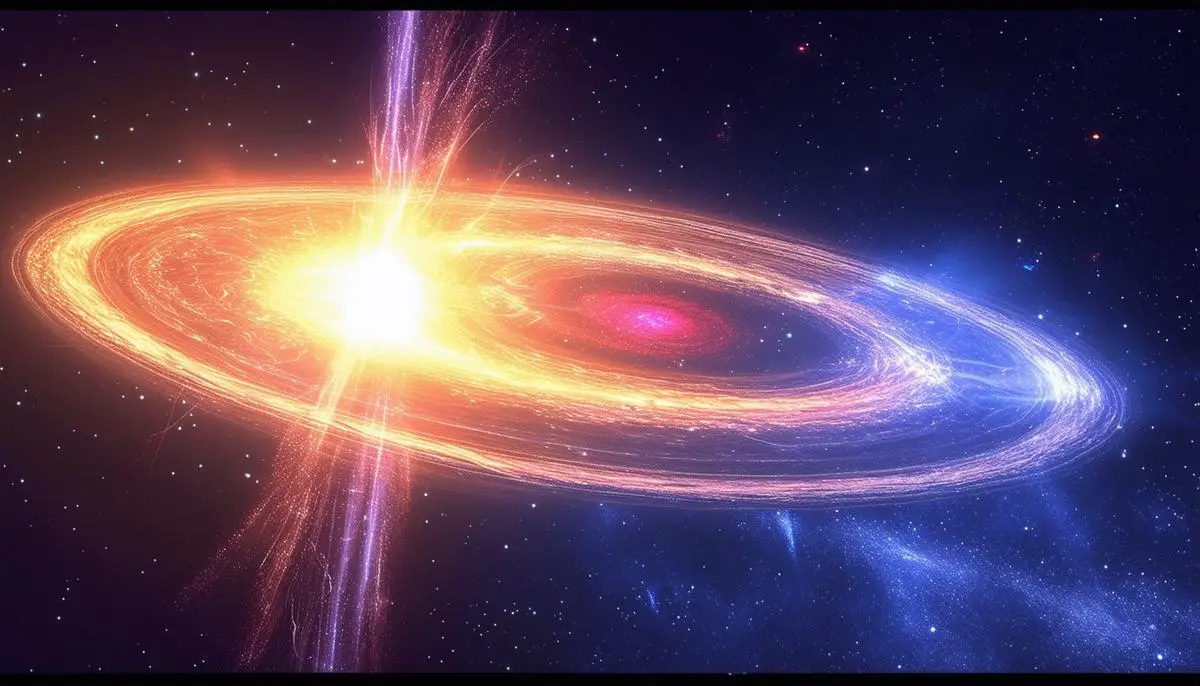
Future Research and Technological Advances
The future of stellar wind research is promising, with several upcoming missions and technological innovations set to enhance our understanding of these cosmic phenomena.
Upcoming Space Missions
- Athena (Advanced Telescope for High-ENergy Astrophysics): Scheduled for launch in the early 2030s, it will provide unprecedented insights into high-energy phenomena, including stellar winds. Its X-ray Integral Field Unit (X-IFU) spectrometer will allow scientists to discern finer structures and ratios of emission lines produced by stellar wind interactions.
- Parker Solar Probe: Continues its mission to study the Sun's corona and gather first-hand data on solar wind origins and dynamics. By measuring the speed, temperature, and density of charged particles in the solar wind, as well as the magnetic fields that guide them, the probe is uncovering crucial information about the sun's outer atmosphere.
Ground-based Observatories
Ground-based observatories equipped with adaptive optics and advanced spectrometers are enhancing their capabilities to observe stars with high precision. The European Southern Observatory's Extremely Large Telescope (ELT) will soon offer incredibly detailed observations of stellar atmospheres, allowing for more accurate measurements of stellar wind properties.
Space Telescopes and Exoplanet Missions
- James Webb Space Telescope (JWST): Will expand our understanding of interactions between stellar winds and planetary atmospheres. Its infrared capabilities will enable investigation of the thermal environments of exoplanetary systems.
- TESS (Transiting Exoplanet Survey Satellite) and PLATO (PLAnetary Transits and Oscillations of stars): Will provide an extensive database of exoplanets orbiting various stellar types, including those with particularly strong stellar winds.
Finally, the application of artificial intelligence and machine learning is revolutionizing the analysis of astronomical data, offering new ways to model complex interactions between stellar winds and their surrounding environments.
These advancements in technology and methodology promise to deepen our insights into the dynamic processes that govern star and planetary system formation, ultimately enriching our understanding of the cosmos and the nature of habitable worlds.
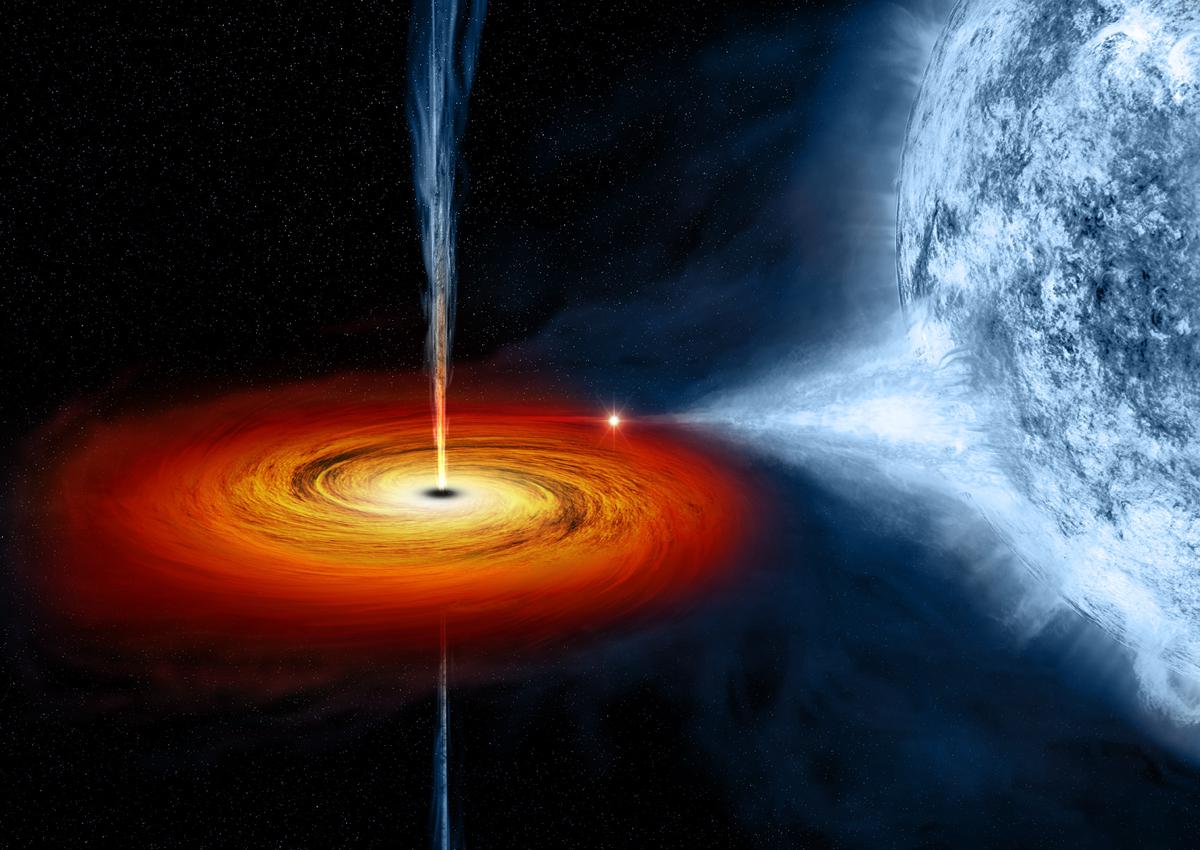
In summary, stellar winds are fundamental agents in shaping the formation and evolution of solar systems. From clearing protoplanetary disks to influencing planetary atmospheres, these cosmic forces play a pivotal role in the dynamic processes that characterize our universe. As our technology advances, we will continue to uncover the intricate ways in which stellar winds impact the cosmos, enriching our understanding of planetary systems, including our own.
![]()
